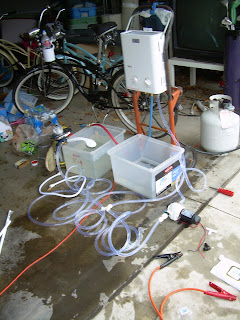Electricity, the nervous system of our homes, is something we do take for granted, don't we? Without it, where would we be? What if we did light fires to keep us warm and to cook our meals? One thing's for sure. We would be doubled over with coughing fits due to the hazy soot in the air that would certainly block the wonderful view I have of the snow capped peaks near my home.
I actually thought about using an alcohol burning stove in my van, along with oil lamps for lighting. The heat would have killed me if the carbon monoxide poisoning didn't, and both of those sources of energy are hardly sustainable or cheap.
Which brings me to the matter at hand -- sustainable energy. My source for power will be the sun. I've done ample reading on the 12 volt system and believe me, there are still plenty of questions I'll have for the phone sales attendant while I place my solar panel and battery order.
I've learned that 6 volt batteries in series are better than one 12 battery alone. I've learned that a battery should never be depleated by more than 25% of its total capacity if it's to be charged quickly back to full. I've learned that a 200 watt solar system will replace 70amps of my daily electrical usage over the course of 5 to 6 hours of quality sunlight exposure.
Taking advantage of the ability of my van's engine to supply supplemental charging power for the batteries, should the sun stay barricaded behind a cloudy sky, I will need an alternator that can put out roughtly 120amps.
Wire gauge is everything, if it's going to carry the electrons to my appliances and lights in an efficient manner. Did you know that you can get an LED light fixture that uses 1 single watt of electricity?
An average house is wired for the potential of 200 amps of power, and my battery bank will have 220 amp-hours of storage. But, at 12volts, that's not very much, because Volts x Amps = Watts. Fascinating stuff.
Today I spent several hours figuring out my schematic for all of my electrical needs. I'll want to be able to access 12 volt outlets (automotive cigarette lighters) at the kitchen counter, at my kitchen table, in the bathroom, and by the bed. I'll want to have access to a regular household 120volt outlet at those locations as well, but only on the rare occasion when I will need the inverter flipped on. It's more efficient to go with 12 volt appliances as much as possible including shavers, hair blowers, blenders, etc.
I'll want to have access to a USB port at the kitchen table, so I can plug my lap top into the wall. I'll have to link it at the other end, in my utility closet, where the printer and scanner will be (yes, wired into the wall ). There will also have to be a 120volt household outlet in the closet for the printer to get its power. Reading lights over the bed and some cool directional spots over the dinette will ad some mood, and my stereo will ad ambience with the help of the ipod that will slide easily into its wall mount nearby. Whew! So much to consider. It's really like building a house.
But, if I'm going to consider it at all, not to mention devoting the amount of time I have thus far, then why skimp? As I've said, research is free, and planning saves time.
Time is money, and I don't want to waste either.














